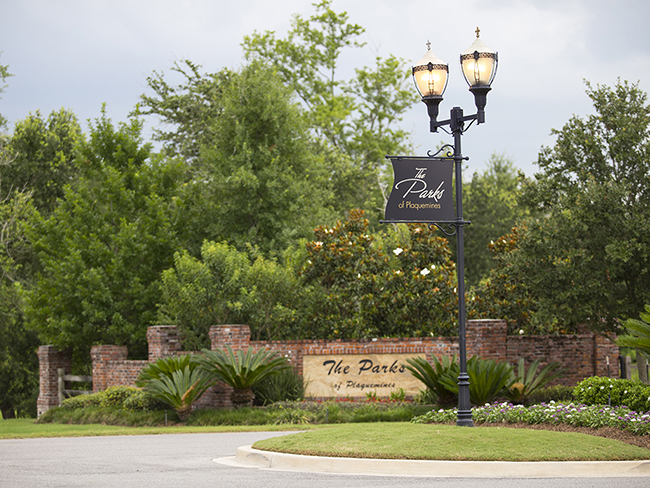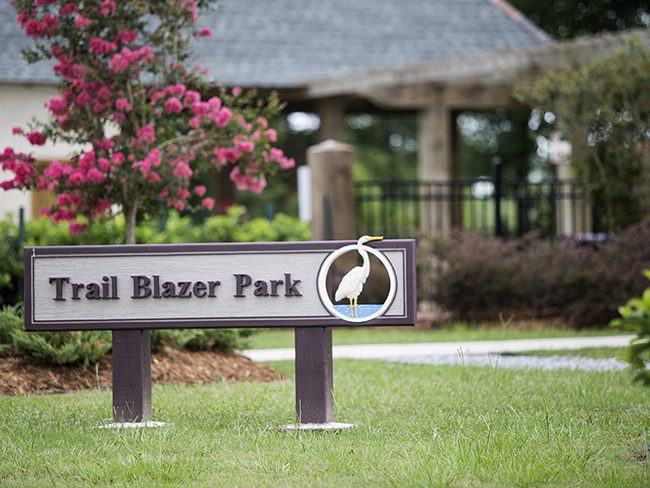Land on the West Bank, Close to New Orleans
Sometimes, the southern region of the crescent in the Crescent City of New Orleans gets overlooked for its potential to offer benefits for those home buyers who are interested in being near New Orleans but not necessarily living in the city of New Orleans. Land on the West Bank is still available in an established, master planned community just over the Intercoastal Waterway in Plaquemines Parish. Plaquemines Parish is an odd-shaped piece of land that extends from the “base” of New Orleans all the way down to where the land seems to disappear into the marsh. Because of this, the parish gets a reputation for being flood prone or “too far south” to be livable for those looking to commute to work everyday in the Central Business District (CBD).
At The Parks of Plaquemines in Belle Chasse, Louisiana, we offer the best of both worlds. You can live in a parish that has significantly lower bills (taxes, city rents, utilities), in a gated community, in a safe environment (only one way in or out of the parish from our location with low crime), only 10.2 miles from downtown New Orleans. Also, a  HUGE perk of choosing to live just outside of the city limits is the fact that Plaquemines Parish has one of the best rated school districts in the state of Louisiana, so if you are moving with your family, there is a guaranteed quality school district to send your children.
HUGE perk of choosing to live just outside of the city limits is the fact that Plaquemines Parish has one of the best rated school districts in the state of Louisiana, so if you are moving with your family, there is a guaranteed quality school district to send your children.
The subdivision itself also has a lot to offer. In addition to being able to buy your own lot and custom build your new home (if you wish); you can also enjoy walking and hiking trails carved out around the community. Inside the community we have built a community swimming pool, tot lot / playground, and tennis courts as amenities for our new home buyers. New Homes are available now at The Parks of Plaquemines, and we are slowly building out the community with both traditional housing as well as new construction garden homes in our Villas Neighborhood.
Our master planned neighborhood is located near everything the West Bank in Jefferson Parish has to offer with shopping, dining, and entertainment locations, the day-to-day office visits that are “life necessary” such as doctor’s  and dentist’s visits, veterinarian appointments, and even home business visits such as accountants and lawyers. There are two ways to access New Orleans – across the Crescent City Connection bridge or by ferry at Algiers Point. New ferry boats are in the works because of a bill signed recently by the governor to get them operational as well.
and dentist’s visits, veterinarian appointments, and even home business visits such as accountants and lawyers. There are two ways to access New Orleans – across the Crescent City Connection bridge or by ferry at Algiers Point. New ferry boats are in the works because of a bill signed recently by the governor to get them operational as well.
Real estate in New Orleans is scarce, and prices are higher because of supply and demand. If you are interested in living in an established neighborhood, you may want to consider living a little bit farther away in the comfort of a beautifully maintained and quality built subdivision such as The Parks of Plaquemines. Contact Us at 504-364-2350 or E-mail [email protected] for more information.

 this was a wake-up call for all communities in the area of buildings’ resilience to storms. Buildings must be built with every detail looked at when facing the challenge of a major storm. Not only did New Orleans need to have many buildings rebuilt, but they also needed to be built better than before. Part of this process was not only to focus on the buildings themselves but the land and environment around the community. This was done by restoring marshland and wetlands that aid in absorbing floodwaters, building affordable houses with green technology, and using other means of building that do not solely depend on oil and gas.
this was a wake-up call for all communities in the area of buildings’ resilience to storms. Buildings must be built with every detail looked at when facing the challenge of a major storm. Not only did New Orleans need to have many buildings rebuilt, but they also needed to be built better than before. Part of this process was not only to focus on the buildings themselves but the land and environment around the community. This was done by restoring marshland and wetlands that aid in absorbing floodwaters, building affordable houses with green technology, and using other means of building that do not solely depend on oil and gas. tourist oceanfront resorts have all been affected by the climate change which includes rising sea levels, extreme heat, drought and stronger storm activity. Marshall explained, “As the resilience movement has gained momentum, we are seeing innovative approaches to the planning, design, development, financing, and insuring of real estate.”
tourist oceanfront resorts have all been affected by the climate change which includes rising sea levels, extreme heat, drought and stronger storm activity. Marshall explained, “As the resilience movement has gained momentum, we are seeing innovative approaches to the planning, design, development, financing, and insuring of real estate.” end with Chubby Carrier & The Bayou Swamp Band at 5:30pm.
end with Chubby Carrier & The Bayou Swamp Band at 5:30pm. Agency moved into the building after Hurricane Katrina. The new owners plan to lease to multiple local and regional businesses for now but in the future they might convert the office building to condominiums.
Agency moved into the building after Hurricane Katrina. The new owners plan to lease to multiple local and regional businesses for now but in the future they might convert the office building to condominiums. neighborhoods seeing some sort of increase. In general, 40 of the 72 neighborhoods have already recovered 90% of the population pre-Katrina and 16 neighborhoods have actually exceeded their pre-Katrina population.
neighborhoods seeing some sort of increase. In general, 40 of the 72 neighborhoods have already recovered 90% of the population pre-Katrina and 16 neighborhoods have actually exceeded their pre-Katrina population.